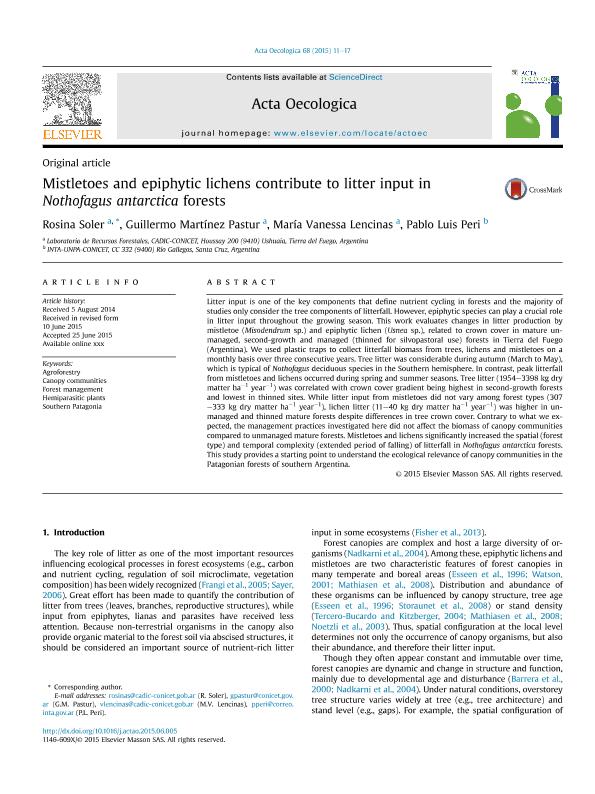Mostrar el registro sencillo del ítem
dc.contributor.author
Soler Esteban, Rosina Matilde

dc.contributor.author
Martínez Pastur, Guillermo José

dc.contributor.author
Lencinas, María Vanessa

dc.contributor.author
Peri, Pablo Luis

dc.date.available
2018-04-19T18:52:08Z
dc.date.issued
2015-10
dc.identifier.citation
Soler Esteban, Rosina Matilde; Martínez Pastur, Guillermo José; Lencinas, María Vanessa; Peri, Pablo Luis; Mistletoes and epiphytic lichens contribute to litter input in Nothofagus antarctica forests; Gauthier-Villars/Editions Elsevier; Acta Oecologica; 68; 10-2015; 11-17
dc.identifier.issn
1146-609X
dc.identifier.uri
http://hdl.handle.net/11336/42722
dc.description.abstract
Litter input is one of the key components that define nutrient cycling in forests and the majority of studies only consider the tree components of litterfall. However, epiphytic species can play a crucial role in litter input throughout the growing season. This work evaluates changes in litter production by mistletoe (Misodendrum sp.) and epiphytic lichen (Usnea sp.), related to crown cover in mature unmanaged, second-growth and managed (thinned for silvopastoral use) forests in Tierra del Fuego (Argentina). We used plastic traps to collect litterfall biomass from trees, lichens and mistletoes on a monthly basis over three consecutive years. Tree litter was considerable during autumn (March to May), which is typical of Nothofagus deciduous species in the Southern hemisphere. In contrast, peak litterfall from mistletoes and lichens occurred during spring and summer seasons. Tree litter (1954e3398 kg dry matter ha 1 year 1) was correlated with crown cover gradient being highest in second-growth forests and lowest in thinned sites. While litter input from mistletoes did not vary among forest types (307 e333 kg dry matter ha 1 year 1), lichen litter (11e40 kg dry matter ha 1 year 1) was higher in unmanaged and thinned mature forests despite differences in tree crown cover. Contrary to what we expected, the management practices investigated here did not affect the biomass of canopy communities compared to unmanaged mature forests. Mistletoes and lichens significantly increased the spatial (forest type) and temporal complexity (extended period of falling) of litterfall in Nothofagus antarctica forests. This study provides a starting point to understand the ecological relevance of canopy communities in the Patagonian forests of southern Argentina.
dc.format
application/pdf
dc.language.iso
eng
dc.publisher
Gauthier-Villars/Editions Elsevier

dc.rights
info:eu-repo/semantics/openAccess
dc.rights.uri
https://creativecommons.org/licenses/by-nc-sa/2.5/ar/
dc.subject
Agroforestry
dc.subject
Canopy Communities
dc.subject
Forest Management
dc.subject
Hemiparasitic Plants
dc.subject.classification
Otras Ciencias Biológicas

dc.subject.classification
Ciencias Biológicas

dc.subject.classification
CIENCIAS NATURALES Y EXACTAS

dc.title
Mistletoes and epiphytic lichens contribute to litter input in Nothofagus antarctica forests
dc.type
info:eu-repo/semantics/article
dc.type
info:ar-repo/semantics/artículo
dc.type
info:eu-repo/semantics/publishedVersion
dc.date.updated
2018-04-17T13:57:21Z
dc.journal.volume
68
dc.journal.pagination
11-17
dc.journal.pais
Francia

dc.journal.ciudad
París
dc.description.fil
Fil: Soler Esteban, Rosina Matilde. Consejo Nacional de Investigaciones Científicas y Técnicas. Centro Austral de Investigaciones Científicas; Argentina
dc.description.fil
Fil: Martínez Pastur, Guillermo José. Consejo Nacional de Investigaciones Científicas y Técnicas. Centro Austral de Investigaciones Científicas; Argentina
dc.description.fil
Fil: Lencinas, María Vanessa. Consejo Nacional de Investigaciones Científicas y Técnicas. Centro Austral de Investigaciones Científicas; Argentina
dc.description.fil
Fil: Peri, Pablo Luis. Consejo Nacional de Investigaciones Científicas y Técnicas; Argentina. Universidad Nacional de la Patagonia Austral. Unidad Académica Río Gallegos; Argentina. Instituto Nacional de Tecnología Agropecuaria; Argentina
dc.journal.title
Acta Oecologica

dc.relation.alternativeid
info:eu-repo/semantics/altIdentifier/doi/http://dx.doi.org/10.1016/j.actao.2015.06.005
dc.relation.alternativeid
info:eu-repo/semantics/altIdentifier/url/https://www.sciencedirect.com/science/article/pii/S1146609X15300011
Archivos asociados
